Teaching With Documents:
Migration North to Alaska
Background
 National History Day's 1998 theme encourages students to investigate topics related to Migration in History: People, Ideas, Culture.
National History Day's 1998 theme encourages students to investigate topics related to Migration in History: People, Ideas, Culture.
Records held by the National Archives and Records Administration document many such migrations and provide countless suggestions for project topics.
The Gold Rush The following photographs, letters, drawings, and acts highlight some of the economic, social, and political factors that prompted thousands to migrate . . .
The Alaska Gold Rush
In 1880 Joe Juneau discovered gold in the Silverbow Basin of Alaska. This discovery, and subsequent discoveries in the Klondike, Yukon region, and elsewhere prompted thousands to migrate to the territory hoping to strike it rich.
The National Park Service provides valuable information on the Alaska Gold Rush.The Klondike Gold Rush National Historic Park and Klondike Gold Rush Seattle Unit National Historic Park also provide useful information.
The Documents
An Overview Of Its Political History
"How firm we stand and plant our feet upon our land determines the strength of our children's heartbeats."
Polly Koutchak, Unalakleet
Alaska Native Peoples
The land now known as the state of Alaska has been continuously inhabited by Native peoples for thousands of years: the Tlingit, Haida, and Tsimshian of the southeastern coastal rainforest; the Athabascan tribes of the interior; the Aleut people of the Aleutian Chain and Pribilof Islands; the Yup'ik people of the Yukon-Kuskokwim Delta and coastal southwest Alaska; and the Inupiat of the northern coast of the Chukchi and Beaufort Seas. The Aleut word alaxsxag or agunalaksh, meaning the "great land" or "shores where the sea breaks its back" may be the source of the name "Alaska." The Aleut people have lived in the Aleutian Islands for more than 9,000 years, "a longer continuous existence as an identifiable people in one place than any other people in the world." The Native peoples of Alaska, comprising distinct languages, cultures, and traditions, share a close connection with the land and sea. As Justice Thomas Berger writes in Village Journey: "The traditional economy is based on subsistence activities that require special skills and a complex understanding of the local environment that enables people to live directly from the land." Subsistence is a word used to describe the hunting, fishing, and gathering traditions of Alaska Native peoples that includes the cultural and spiritual values of respect, sharing, love of the land, and integral relations among humans, animals, and the environment. "If you respect things and look at them as having a spirit or being, then you're in a place where you're at a balance. You look at the world that way and respect it and you see that it's providing you with a way of life, and your kids."Gabriel George, Angoon.
History of Exploitation
Alaska's recent history of the last 250 years is punctuated by a series of boom-and-bust cycles of exploitation of natural resources by European and European-American colonists in search of fur, whales, gold, copper, salmon, and oil. Promyshlenniki, or Russian fur traders, arrived in Alaska in the 1740's. Traders from Siberia exploited the superior kayaking and hunting skills of the Aleut people by forcing them into slavery to kill sea otters from Alaska to Baja California. In the sixty years following Vitus Bering's claim of Alaska for Russia in 1741, the Aleut population declined from 15,000 to 2,000. People died from European diseases such as smallpox and measles for which they had no immunity. The northern coast of Alaska was invaded by the "original oil men from the South," the Yankee whalers in search of whale oil and baleen, who nearly decimated the bowhead whale population in the Beaufort and Chukchi Seas in the mid-1800's.
As Russia wiped out the sea otters, its interest in Alaska waned. In 1867, the Tsar of Russia reached an agreement with then U.S. Secretary of State William H. Seward to sell Alaska to the United States for 7.2 million USD, about 2 cents per acre. Seward was widely criticized for the deal to acquire what some perceived as a frozen wasteland and the agreement became known as "Seward's folly." For Seward, the agreement fulfilled his dream of manifest destiny. The sovereign rights of the Alaska Native peoples were ignored in the transaction.
In the decades that followed, gold strikes began in southeast Alaska and expanded into Interior Alaska and to the Bering Sea around Nome. The gold rush rapidly transformed Alaska. Outsiders with gold fever now numbered in the thousands. Early efforts to establish Alaska as a state failed, although in 1906 Alaska had a non-voting delegate in the U.S. House of Representatives. Railroads and roads were built to facilitate the export of gold, copper, and coal.
World War II and the Cold War highlighted Alaska's strategic importance and ended the Territory's political isolation. In 1942, the 1,400 mile Alaska Canada Military Highway between Dawson Creek, British Columbia and Delta Junction near Fairbanks, was built in 8 months at a cost of $138 million. Alaska's strategic military significance and growing economic importance with the prospect of oil, prompted Congress to approve Alaska's statehood in 1958. Alaska became the 49th state.
Oil!
In 1902, the New York Times reported: "An immense oil gusher was struck at Cotella [sic] on the south Alaskan coast. An important new industry is thus added to Alaska's resources." The Katalla discovery, about 110 miles southeast of Valdez, only resulted in a local boom and dreams were dashed when the small refinery was destroyed by fire in 1933. The search for commercial discoveries of oil had begun. Irene Ryan, a geological engineer and bush pilot stated: "I felt people should be looking for oil instead of gold. Everyone thought I was nuts."
In the early 1950's, nationalization of Iran's oil fields and attempts to close the Suez Canal led oil companies to seriously approach potential oil reserves in Alaska. Oil companies began to purchase vast acreage in oil leases, with over 5 million acres leased by the end of 1955. After about 165 consecutive oil well failures by oil companies in Alaska, Richfield, a small California company that later merged with Atlantic Refining and became ARCO, struck oil in the Swanson River area of the Kenai Peninsula in 1957. The well soon produced 900 barrels of oil per day, the first commercially productive well in Alaska. The Kenai Peninsula and Cook Inlet region became an important producer of oil and natural gas, with 15 offshore oil platforms, on-shore oil and gas production, large processing, refining, and transportation facilities.
Atlantic Richfield struck an 'elephant' field at Prudhoe Bay along the Beaufort Sea coast in 1968. With a capacity of 10 billion barrels, it became the country's largest oilfield. Oil companies honed in like sharks. In 1969, Alaska received over $900 million in one oil lease sale alone. Five years after the Prudhoe Bay discovery, Congress approved construction of the Trans-Alaska Pipeline System (TAPS), with then Vice-President Spiro Agnew casting the deciding vote in the United States Senate. The pipeline, operated by a consortium of seven oil companies forming Alyeska Pipeline Service Company, traverses 800 miles from Prudhoe Bay to tidewater in Valdez on Prince William Sound. On June 20, 1977 the first oil from Prudhoe Bay flowed southward. At peak capacity, TAPS carried 2 million barrels of oil per day. Nearly one-tenth of the crude oil consumed in the United States flows from Prudhoe Bay through TAPS.
Alaska Native Claims Settlement Act
Oil companies lobbied hard for the passage of the Alaska Native Claims Settlement Act (ANCSA) because they feared that Native claims along the proposed TAPS route might prohibit the granting of right of way. ANCSA, passed in 1971, gave Alaska Natives title to 44 million acres and $962 million to settle aboriginal land claims. ANCSA was the largest land claim settlement in U.S. history. Each Alaska Native became a stockholder and received 100 shares in one of twelve regional corporations. ANCSA was set up for failure. ANCSA was negotiated by few who did not represent most Alaska Native people. As Lillian Liliabas questioned: "Who voted for ANCSA? You won't find ten people on the Kuskokwim who voted for ANCSA." "The imposition of a settlement of land claims that is based on corporate structures was an inappropriate choice. The village has lost its political and social autonomy."-Justice Thomas Berger
Alaska Native tribes are asserting their rights to protect their lands and subsistence way of life through legal and political avenues. The recent Venetie decision by the US Ninth Circuit Court of Appeal, establishes that ANCSA did not extinguish Indian country and that the village of Venetie has the right to impose a tax on an outside contractor. This decision has sparked racist fearmongering, especially from politicians who represent corporate interests. The Governor and the state legislature appropriated $1 million to appeal the decision to the U.S. Supreme Court.
Politicians Bought and Sold
Fully 85% of Alaska's government revenue comes from the oil and gas industry. Industry contributions also fill a hefty portion of the politicians' campaign chests. Many Alaskans are lulled into complacency with the average of about $1,000 per year return on the Permanent Fund Dividend, a state-managed trust fund created from oil royalties. In turn, the oil industry receives little scrutiny from state and federal regulators.
The lack of government oversight of the oil industry in Alaska has created serious problems that threaten the environment, human health and safety. The tragic Exxon Valdez oil spill that poisoned over 1,000 miles of Alaska's coastline was a culmination of government complacency. A recent report commissioned by the Alaska Forum for Environmental Responsibility concludes that "Alyeska's efforts are not sufficient to protect the environment TAPS crosses, and the health and safety of its workers, from the risks of an aging pipeline." Oil companies in Cook Inlet committed thousands of violations of their Clean Water Act permit from 1987-1995. With a special exemption for Cook Inlet, EPA allows the oil industry to dump millions of pounds of toxic waste each year.
Despite its failure to act responsibly, the industry is granted access to virtually the entire coastline of the Beaufort Sea and Cook Inlet through special area-wide state and vast federal lease sales. The state has spent millions of dollars to lobby Congress to open the Arctic National Wildlife Refuge to oil development, a move supported by Alaska's Congressional delegation. Meanwhile, the industry encroaches on the borders of the Refuge through its Warthog, Sourdough, and other prospects. The Minerals Management Service is offering lease sales in the Chukchi, Beaufort, Gulf of Alaska, and Cook Inlet. Plans to open the National Petroleum Reserve are also proceeding
http://archive.greenpeace.org/comms/97/arctic/library/region/native.html
The Geography of Alaska
Alaska's Location
Relative location tells us where something is in relation to other places. In the 1930’s, General Billy Mitchell claimed that Alaska was the center of the world. Of course, at the same time, most Alaskans thought of their semi-isolation and considered their territory as being near the ‘edge’ of the world.
Absolute location refers to a geographic address. For many Alaskans their mailing address is one way they answer where exactly they are at. Of course, that location might be a post office box address: P.O. Box 1, Any City, Alaska. That address places those people at the local community U.S. Post Office. For others, that address might be a street address: 100 West Main Street, Anytown, Alaska. We will look at other ways of identifying exact location below.
Together, these location systems—relative and absolute—provide us with a way of understanding where we are in the world.
Relative Location: Where is Alaska?
What could General Mitchell possibly be thinking of when he made his claim that Alaska was at the center of the world? General Mitchell had spent part of his military career in Alaska. He was involved with the Signal Corps so he knew something about the territory.
He also had a fascination with aircraft and felt that the U.S. military needed to bolster its air force. (At the time, there was no U.S. Air Force.)
General Mitchell looked at Alaska on a globe. He saw that Alaska was approximately equal distance from all of the major urban-industrial centers of the world. Figure L.1 is a map of Alaska as seen from space. It is centered on Lake Minchumina in Interior Alaska. Note that we can see the major centers of Asia (Tokyo and Bejing are shown), Europe (Moscow, Berlin, Paris, and London are shown), and North America (New York, Toronto, and Los Angeles are shown). General Mitchell viewed Alaska’s relative location and found that it was, indeed, central to the urban-industrial world.
We can view Alaska’s relative location from a number of perspectives. For simplicity, we will identify Alaska as part of the North Pacific, the Northern world, the North American continent, and the United States.
North Pacific. The commonly accepted theory of the initial occupation of Alaska is that people migrated from Asia over different periods of time. One advantageous time period was during the Pleistocene glacial period when the vast area of Beringia existed. People could move along the coastline from one continent to the other as the water barrier was non-existent. Of course, even the waters of the Bering Strait have proven to be no real barrier to Inupiat and Chukchi peoples who have moved back and forth between North America and Asia for centuries.
When Alaska was known as “Russian America” its relative location was different than today. The Russians named part of the Aleutian Islands the “Near Islands.” We certainly do not think of Attu Island as “near” to the rest of Alaska or the United States. But, it was near to Russia. Attu Island was controlled by the Russian America Company (Figure L.2).
Today, Anchorage International Airport is one of the busiest air cargo ports in the world, handling cargo between Asia, Europe, and North America. Alaska’s location along a convenient North America-Asia Great Circle shipping route was well understood by both the Russia America Company and the U.S. government in the 19th century (Figure L.3).
Northern World. If we look at Figure L.1 again, we can see how Alaska is part of the Northern world. We share the Arctic Ocean waters with Russia, Sweden, Norway, Greenland, and Canada. The Arctic Circle, an arbitrary line of latitude at 66.5° North, crosses all of the above countries plus Finland (which is blocked from the Arctic Ocean). Thus, all of these countries (and Alaska) share a similar environment. International conferences on changing northern climate and permafrost draw participants from across the northern world. Similarly, institutions have been formed that are founded on the shared northern situation. Examples include the Arctic Council (amongst countries) and the Northern Forum (amongst northern regional governments such as Alaska).
This is a good place to pause and consider Alaska’s relative size. Alaskans are proud of the size of their state—589,000 square miles or over three times the size of California. Yet, in the context of the northern world, its size is modest, being exceeded by regions such as the Northwest Territories and Nunavut in Canada, Greenland, and Sakha in Russia.
North America. Alaska is also part of North America. (Figure L.4) Indeed, it is physically attached to North America, sticking out at the northwest portion of the continent as a large peninsula. Alaska’s linkages with the rest of North America are many. In physical geography the examples include mountain ranges (Rocky Mountain and Coastal Mountain systems), climate (arctic and sub arctic), glaciers, vegetation (tundra and boreal forest), and animals (moose, raven). In human geography the examples include centuries of dispersal of Inupiat and Athabaskan peoples. Alaska’s transportation linkage with the rest of North America became a reality in World War II with the completion of the Alaska Highway. At that same time an oil pipeline was completed to Alaska; however, it linked only the Northwest Territories (Norman Wells), the Yukon Territory, and Alaska. The line did not link to the main distribution lines of North America. Yet, today, discussions for future linkages of Alaska with the rest of North America include a railroad and a natural gas pipeline.
United States. Since 1867, of course, Alaska has been part of the United States, and since 1959, it has been a state within the United States. Alaska accounts for 17 percent of the total U.S. area and 64 percent of the U.S. coastline. Along with Canada, the U.S. borders on the Arctic Ocean, Pacific Ocean, and Atlantic Ocean.
Where in Alaska?
We have looked at Alaska relative to other places and regions. But within Alaska we can see how a relative location perspective can be very helpful. Imagine you are a high school student from California attending a meeting or a sporting event with students from other areas of the western states. You happen to sit at a table for dinner with students from Barrow, Fairbanks, and Ketchikan. To start the conversation, you ask the polite question, “What’s it like in Alaska?” Image the different responses you would get! You might be inclined to ask if the three students were, in fact, from the same state. The shear size and distances between places account for the great differences between places. Additionally, there are great environmental differences between these areas that are separated by mountain ranges and 15 degrees of latitude.
Air travel. Figure L.5 provides a way of grasping the distances between places in Alaska. While large, the distances are reduced if one thinks of air miles by plane. Anchorage is just over an hour and a half from Juneau. Nome is just over an hour from Anchorage by air. Adak is over 4 hours from Anchorage by air. However, when one considers weather delays, the times could be greatly extended. Travel between Anchorage and Unalaska is sometimes delayed for days because of weather.
Since Alaska has few roads, the sense of remoteness is often amplified. This is especially true in much of the rural portion of the state where there are no roads connecting to the main Alaska Highway grid (Figure L.6). The capital, Juneau, is inaccessible by road, unless, of course, one includes the Alaska Marine Highway. Even then, one has to travel to Canada in order to enter the Southeastern Panhandle region of the state.
Center points (Figure L.7). Another way to view relative location is to consider where Alaska’s center points are found. If we were to cut out a map of Alaska from a piece of paper and balance the map on the point of a pencil, we would have found the center point of the physical structure of the state. That point is at 63°50’ N, 152° W. or near Lake Minchumina. In a similar way, if we were to find the center for the population of Alaska (based on the numbers of people in each settlement) Anchorage would be the center of the state. Lake Minchumina is 205 miles to the northwest of Anchorage.
Absolute Location
In contrast to relative location which compares a location with what surrounds it, absolute location refers to exact location. We can express this location mathematically using different geographical systems.
Latitude and longitude is the most commonly used system. It is based on degrees of latitude (90° north and 90° south with the center at the Equator) and longitude (180° east and 180° west calculated from the Prime Meridian). This location system divides each degree into 60 minutes and each minute into 60 seconds. If you wanted to identify the National Park Service headquarters for Denali National Park it would be:
63° 43’ 20” N, 148° 57’ 48” W
According to this system, Alaska has the distinction of being in both the eastern and the western hemisphere. The Rat Islands and Near Islands lie in the Eastern Hemisphere. Thus, Alaska is sometimes the subject of trivia game questions: “What is the northernmost, westernmost, and easternmost state of the United States?”
Using this system, we can see that Alaska extends over a vast area. Here are its key extents:
South: 51° 13’ N. at the tip of Amatignak Island in the Aleutian Islands
North: 71° 23’ N. at Point Barrow
East (towards Canada): 129° 59’ W. at Cape Point in Southeast Alaska
West (towards Russia): 172° 27’ E. at Cape Wrangell on Attu Island
While the distance between the northern and southern points is 1,420 miles (2,285 km) and the distance between the eastern and western points is 2,400 miles (3,862 km), Alaska definitely does not have a neat rectangular shape. The Aleutian Islands extend out so far from the main body of Alaska that they are rarely shown on maps in their proper location. Not surprisingly, Alaska’s 6,640 miles (10,700 km) of coastline amount to over half of the total coastline of the United States.
Alaska’s size, by U.S. standards, is enormous. It accounts for 16 percent of the U.S. area. More specifically, Alaska’s 589,194 square miles (1,525,953 km2) consists of 571,951 square miles of land (1,481,296 km2) and 17,243 square miles (44,658 km2) of inland waters.http://www.akhistorycourse.org/articles/article.php?artID=121
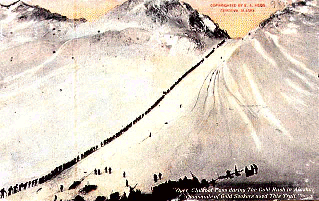
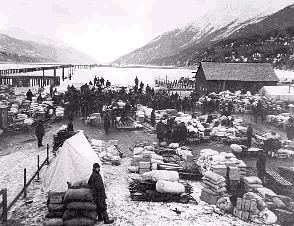











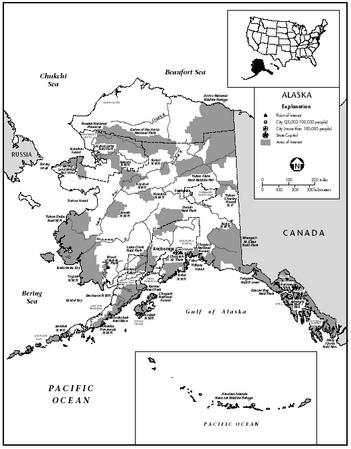
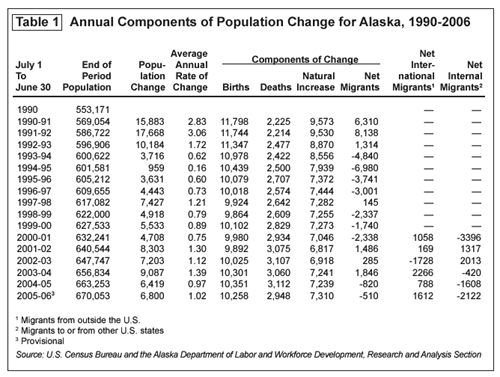
 The discovery and development of the A-J and Treadwell gold deposits eventually led to the location of the State Capitol. This was followed by the discovery of the Fortymile, Central, Nome, Fairbanks, Iditarod, and many other significant placer gold districts.
The discovery and development of the A-J and Treadwell gold deposits eventually led to the location of the State Capitol. This was followed by the discovery of the Fortymile, Central, Nome, Fairbanks, Iditarod, and many other significant placer gold districts. 
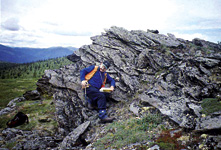
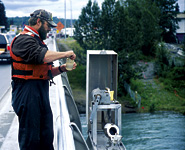
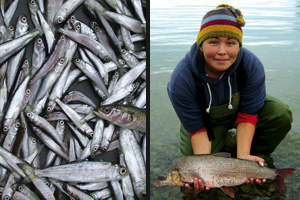


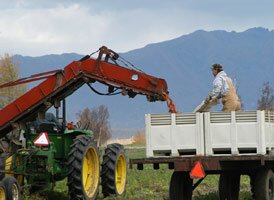 Everyone in the Valley agrees that Alaska is a great place to farm because of the cooler temperatures. VanderWeele said this is because the climate reduces the amount of pesticides necessary, there is less disease, and the land is cleaner overall. With these benefits, the VanderWeele Farms are able to emphasize the care "that grows into VanderWeele crops."
Everyone in the Valley agrees that Alaska is a great place to farm because of the cooler temperatures. VanderWeele said this is because the climate reduces the amount of pesticides necessary, there is less disease, and the land is cleaner overall. With these benefits, the VanderWeele Farms are able to emphasize the care "that grows into VanderWeele crops."
